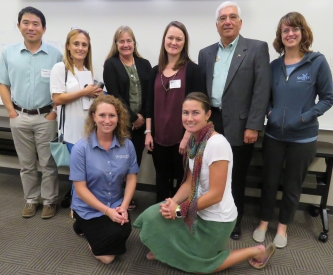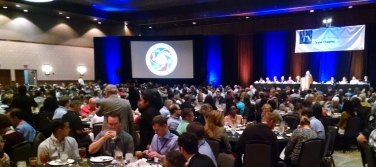The goal of this project is to link science communication and municipal planning to improve and transform coastal resilience. This is a partnership between Mission-Aransas Reserve, COMPASS Science Communication, and the Gulf of Mexico Coastal Training Program, working closely with local municipalities, including City of Rockport’s Mayor Pro Tem and Community Planner, Nueces County Director of Coastal Parks, and social scientists in Strategic Planning and Policy at Harte Research Institute for Gulf of Mexico Studies. The project is funded by the Gulf of Mexico Alliance 2017 Gulf Star Program.

Panelists and participants at resilience workshop on October, 31, 2017
In the devastating aftermath of Hurricane Harvey, this motivated group of individuals set aside their shovels, saws, and storm recovery duties to unite at Corpus Christi Small Business Development Center with participants from the Texas Coastal Bend to discuss collaborative opportunities, barriers, and next steps for building (and rebuilding) more resilient coastal communities. This boundary-spanning workshop was attended by representatives from academia, county and city officials, river authority and planners. The project team facilitated poignant conversations about the importance of communicating science to improve resiliency and hazard mitigation initiatives along the coastal bend and beyond.
Outcomes from workshop discussions include examples of how pre-Harvey resilience efforts reduced loss of life and property. We explored science-backed building standards that local leaders are implementing to increase resiliency, as well as new offers to collaborate across sectors to merge science, policy, and planning to increase community benefits.
For example, City of Rockport Mayor Pro Tem, Pat Rios, reported that Rockport’s resilience efforts greatly reduced the potential damage and loss from Harvey. His team took advantage of the 1.5 hours during the eye of the storm to go out and investigate the condition of the water treatment plant and other resources. They realized that local requirements to build 18” above standards, and construct braces on buildings, led to them feeling proud of how much they didn’t lose compared to how much would have been lost if they had not required higher building standards. Unlike Harris County, which fought against and does not have windstorm building regulations, Rockport and Aransas County recovery efforts will benefit from windstorm protections.
Rockport is leading an effort to hear ideas from developers, researchers, planners, and others, to understand municipal priorities, address stakeholder trust issues, encourage developers to become more educated about impacts to soils, water, and floods and consider a more resilient development model for affordable housing. Many developers express gratitude that Rockport has already done a lot of the legwork for them by identifying floodplain maps and areas available for development, but many still are unaware that their development ideas are impacted by science – and now is the time to act on concrete examples.
Fortified Construction is a focus for Nueces County resiliency efforts. Scott Cross, Director of Coastal Parks for Nueces County reported that Texas Department of Insurance and Texas Windstorm Insurance Association standards for windstorm, roof, doors, and windows is “almost there” with Fortified standards, and would only take a little nudge to get contractors and real estate agents on board.
Next steps include working with the Coastal Training Program to host a Lunch and Learn for realtors, contractors, and developers to share Fortified standards and local efforts that make the community already close to achieving silver or gold Fortified status. These standards will also increase property values, reduce insurance costs, and create a big savings gap and reduce long-term costs to the state. The Lunch and Learn will be a new opportunity to educate realtors and developers, many from Dallas, who may not know about local level standards and values. It will plant a seed about Fortified options that pass the benefits and cost on to the buyer, and increase understanding about how to market the benefits of natural protection, topography, and well thought out development that allows community members to capitalizes on resilient and natural infrastructure.
Building personal relationships with community members and stakeholders is key to advancing education about these benefits, and will likely lead to voluntary enhancements.
Dr. Katya Wowk, Senior Associate for Strategic Planning and Policy at Harte Research Institute for Gulf of Mexico Studies, compared her work with NOAA during Hurricane Sandy recovery, where the 13 states impacted used much of the recovery funds to rebuild exactly the same, in many cases. There is an urgency around not repeating this mistake in the Texas Coastal Bend. Realizing that academia is often not structured to incentivize engagement with policy and social decision-making, Dr. Wowk proposed that the best research and models are insufficient without the best relationships, and offered support from her team to collaborate with local communities to connect the dots between science and planning, and to help them identify funding opportunities.
“Having a resilience plan in place like Rockport, including relationships and forethought, makes communities more competitive for federal funding,” Dr. Wowk suggested.
One workshop participant identified the need to request funding from City Council to study contaminants in water, bays, watersheds, and seafood, and connect results and outcomes to social science and planning efforts. Another participant suggested that this workshop was the first time academics keyed in on wanting to turn a work product into a usable, beneficial product for planning and policy.
Key take-away? If you want to go fast, go alone. If you want to go far, go together.
Overall, better connected scientific and planning communities benefit from leveraging partnerships to work together to achieve common goals. Rockport and Nueces County’s existing relationships with the Coastal Training Program, Climate and Resilience Community of Practice, Gulf of Mexico Alliance, and others make these places more positioned to implement visionary sustainable recovery solutions than other cities and counties that have been less involved in resiliency efforts.
Of course more work is needed! An ongoing need persists to engage community level participation and commitment for resiliency efforts to be effective. In addition to planning a Lunch and Learn, next steps include collaborating to access social science research available from Harte Research Institute, ecological scientific advances from University of Texas Marine Science Institute, and workshop facilitation services from Mission-Aransas Reserve’s Coastal Training Program (CTP). CTP was identified as a useful collaborative resource because of it’s close connections to the community and success at bringing affected stakeholders together to discuss and inform future research and development efforts.
Phase two of this project:
Building on findings from our workshop in Corpus Christi, the project team joined Amanda Torres, City of Rockport Community Planner and Certified Floodplain Manager, to lead a presentation and discussion at the American Planning Association Texas Chapter Annual Conference: The Art of Planning- Uniting Diverse Perspectives. Presentation topics included best practices, case studies, benefits, and opportunities to engage stakeholders and encourage more connected science and planning efforts that result in a multitude of benefits to local communities.

2017 American Planners Association Annual Conference: The Art of Planning, Uniting Diverse Perspectives
Over thirty planning departments, city managers, transportation planners, community development directors, scientists, and others voluntarily attended our session because integrating science into planning efforts was a fairly new topic to many. Others expressed concern about the lack of science informing their work because “you don’t know what you don’t know.”
Comments and discussion highlighted interest from the planning community in forming closer relationships with universities, and initiating mini-projects like this one to increase access to high quality, relevant scientific information. Reputable science is needed to inform planning decisions and improve legitimacy and buy-in when explaining decisions to the public. The audience asked for more workshops that share scientific information and data with City Council, regional planners, engineers, and municipal staff.
Many participants attended our session for the practical communication training. There is a growing thirst for improving cross-sector communication and the flow of information and data in usable formats – reminding us that boundary spanning and interactive training is useful, practical, and continually needed as players in the field change and scientific research and innovation evolve.
Additionally, this project revealed a fast growing interest from Gulf-wide regional planning councils to engage in boundary spanning work across the Gulf of Mexico. This project was developed as a pilot model for other Gulf communities to replicate. Given the needs and interest from Gulf-wide Regional Planning Councils, National Estuarine Research Reserves, National Estuary Programs, and academia, our Gulf Coastal Training Program partners continue to seek opportunities to replicate this effort Gulf-wide so researchers can interact with planners, floodplain managers, developers, and local decision makers to identify needs of local municipalities and take steps to meet those needs.
Contact us to learn more about the project, team, outcomes, next steps, and how you can get involved. Presentations, agendas, and resources from this workshop can be accessed here.
